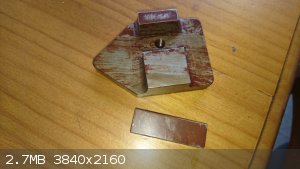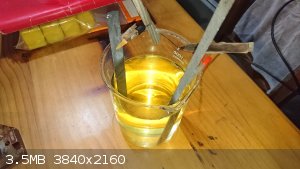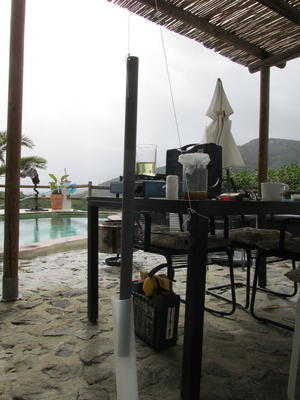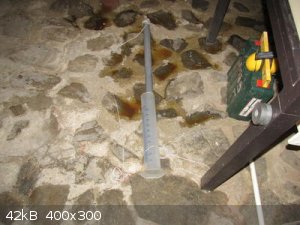| Pages:
1
..
11
12
13
14
15 |
Melgar
Anti-Spam Agent
    
Posts: 2004
Registered: 23-2-2010
Location: Connecticut
Member Is Offline
Mood: Estrified
|
|
Quote: Originally posted by TheNerdyFarmer  | Yesterday I decided to generate some ammonia gas for a separate project of mine. I had the whole gas generating setup built and so I mixed the
reactants and started gas generation. By the way I was making ammonia via ammonium halide salt + alkali metal hydroxide. Any way, the reaction started
and a lot of gas was coming off. There was also a good deal of moisture coming with it. Little did I notice that some (a great deal) of ammonia gas
was leaking from the tubing that I used to make the gas generating setup. Before I realized what was happening I lifted the sash of the fumehood up
and got a huge whiff of ammonia gas. I had forgotten to turn my fume hood on. I quickly turned it on and ran to the other side of the lab. I walked
over to the hood every few seconds and within 2 minutes there was no detection of ammonia gas.
This wasn't a super dangerous situation but it did give me somewhat of a scare considering that ammonia isnt the greatest stuff to inhale.
[Edited on 6-11-2017 by TheNerdyFarmer] |
I kind of like the smell of ammonia, because I've come to associate it with neutralization of HCl vapors. I did this one halogenation reaction a lot
that necessitated generating chlorine gas, and produced HCl gas. Both gases escaped from time to time, and opening my ammonia jug and squeezing it
repeatedly to get the vapors to diffuse would allow me to see where the bad vapors were coming from and stop them. It reacts with Cl2 and HCl in
midair to generate salts, which are visible like smoke.
Incidentally, if you want to generate anhydrous ammonia gas cheaply, the most effective way I know of is heating urea to about 200C. It's super easy
to control; you just turn the heat up or down. It leaves cyanuric acid residue, which you can use to make cyanates or any number of things. It's
hard to clean out of stuff, but will form isocyanuric gas at higher temperatures.
The first step in the process of learning something is admitting that you don't know it already.
I'm givin' the spam shields max power at full warp, but they just dinna have the power! We're gonna have to evacuate to new forum software!
|
|
|
NedsHead
Hazard to Others
  
Posts: 409
Registered: 9-12-2014
Location: South Australia
Member Is Offline
Mood: No Mood
|
|
I managed to contaminate my nitre bluing tank with copper and nickel ions, it's a small pot that I use for bluing tools, about 2 litres containing
approximately 1 mole potassium nitrate and 1 mole potassium hydroxide, I could use some advise on how to go about removing these impurities.
Thanks
|
|
|
ninhydric1
Hazard to Others
  
Posts: 345
Registered: 21-4-2017
Location: Western US
Member Is Offline
Mood: Bleached
|
|
@NedsHead I would assume that the hydroxide ions from the KOH would precipitate the copper and nickel ions from solution. Maybe wait and see if any
precipitate settles to the bottom of the bluing tank?
The philosophy of one century is the common sense of the next.
|
|
|
NedsHead
Hazard to Others
  
Posts: 409
Registered: 9-12-2014
Location: South Australia
Member Is Offline
Mood: No Mood
|
|
Thanks ninhydric1, I made a solution of the bluing salts and was able to filter off the precipitate, it looks to be mostly copper.
below is a picture of the failed part to be blued, it's the components to a vernier height gauge

|
|
|
violet sin
International Hazard
    
Posts: 1475
Registered: 2-9-2012
Location: Daydreaming of uraninite...
Member Is Offline
Mood: Good
|
|
Could you attempt to plate out soluble metal ions with carbon electrodes and then filter or decent your solution. Set it aside long enough to get the
pot clean? I can't say I have tried this, but I would think it might have a chance. Not sure if you want to use the pot as an electrode, cathodic
protection or no. Graphite battery rods and a usb hookup 5v between them may just be easy enough to try for a few min, with little setup effort. If
it works awesome, if not no huge loss.
I did a quick search on that bluing, it had water in the mix, ie. per gallon directions. Yours is the same ya? Or just salts melted when needed for
dipping? Pretty sure I have seen hot dipping that included no water, on you tube. That would be less fun, and possibly a poor memory so incorrect.
|
|
|
TheNerdyFarmer
Hazard to Others
  
Posts: 131
Registered: 30-9-2016
Member Is Offline
Mood: No Mood
|
|
Quote: Originally posted by Melgar  | Quote: Originally posted by TheNerdyFarmer  | Yesterday I decided to generate some ammonia gas for a separate project of mine. I had the whole gas generating setup built and so I mixed the
reactants and started gas generation. By the way I was making ammonia via ammonium halide salt + alkali metal hydroxide. Any way, the reaction started
and a lot of gas was coming off. There was also a good deal of moisture coming with it. Little did I notice that some (a great deal) of ammonia gas
was leaking from the tubing that I used to make the gas generating setup. Before I realized what was happening I lifted the sash of the fumehood up
and got a huge whiff of ammonia gas. I had forgotten to turn my fume hood on. I quickly turned it on and ran to the other side of the lab. I walked
over to the hood every few seconds and within 2 minutes there was no detection of ammonia gas.
This wasn't a super dangerous situation but it did give me somewhat of a scare considering that ammonia isnt the greatest stuff to inhale.
[Edited on 6-11-2017 by TheNerdyFarmer] |
I kind of like the smell of ammonia, because I've come to associate it with neutralization of HCl vapors. I did this one halogenation reaction a lot
that necessitated generating chlorine gas, and produced HCl gas. Both gases escaped from time to time, and opening my ammonia jug and squeezing it
repeatedly to get the vapors to diffuse would allow me to see where the bad vapors were coming from and stop them. It reacts with Cl2 and HCl in
midair to generate salts, which are visible like smoke.
This is clever. I have never thought of using ammonia to detect HCl. I will certainly try this in the future. Thanks for the tip!
Incidentally, if you want to generate anhydrous ammonia gas cheaply, the most effective way I know of is heating urea to about 200C. It's super easy
to control; you just turn the heat up or down. It leaves cyanuric acid residue, which you can use to make cyanates or any number of things. It's
hard to clean out of stuff, but will form isocyanuric gas at higher temperatures. |
I will definitely try this method next. It seems cheap and does not generate a ton a moisture like the other reaction did.
Using ammonia to detect HCl is pretty clever. I don't know why i have never thought of using ammonia to detect HCl before. I will certainly try this
in the future. Thanks for the tip!
[Edited on 10-11-2017 by TheNerdyFarmer]
|
|
|
Melgar
Anti-Spam Agent
    
Posts: 2004
Registered: 23-2-2010
Location: Connecticut
Member Is Offline
Mood: Estrified
|
|
When I first did this reaction, it was for the purpose of generating potassium cyanate by heating a mixture of potassium carbonate and urea. This
reaction was generating enormous volumes of gas, to the point where I had to move everything out of the shop. It just kept going, and going, and
going. Granted, it would have been both CO2 and NH3, but in either case, you'd be getting one gas molecule for each parent molecule. It was annoying
at the time, but then I remembered that reaction at one point later when I actually did need to generate NH3 gas, and used that instead of the typical
"ammonium salt plus a strong base" method. Far superior, in my opinion, and it's much easier to get full conversion without adding undesired water to
the mixture. You may need to use a dryer tube or something, because I don't think urea is typically anhydrous, (I could be wrong though) but there
won't be nearly as much water as the way you were doing it.
Quote: Originally posted by TheNerdyFarmer  | | Using ammonia to detect HCl is pretty clever. I don't know why i have never thought of using ammonia to detect HCl before. I will certainly try this
in the future. Thanks for the tip! |
Note that the resulting salt clouds will set off smoke detectors, and leave white film on glass. But it sure is better than the rust patina that
results from escaped HCl and Cl2 gases. Obviously, you can also use HCl vapors to track NH3 vapors. For either one, I have squeeze bottles of HCl
and NH3 solutions, and I just squeeze the air out of them repeatedly to generate small amounts of vapor when I need it.
There should be a "Tips learned through experience" thread. I'm actually surprised there isn't one.
The first step in the process of learning something is admitting that you don't know it already.
I'm givin' the spam shields max power at full warp, but they just dinna have the power! We're gonna have to evacuate to new forum software!
|
|
|
Geocachmaster
Hazard to Others
  
Posts: 146
Registered: 5-3-2016
Location: Maine, USA
Member Is Offline
Mood: Corroded, just like my spatulas
|
|
Every time I've made an ester I've had low yields, usually in the 50-60% range. Recently I was making diethyl phthalate, and I was determined to get a
high yield. I used a large excess of dry ethanol and 3A molecular sieves in a soxhlet, after distilling off the extra ethanol all traces of water had
essentially been eliminated. I mixed the residue with water to wash out EtOH and H2SO4, which left a dense oily liquid with a volume of a little more
than a quantitative yield. Next I washed with NaHCO3 solution. The first three or four times shaking built up pressure but not too much. Then I shook
the sep funnel again, but this time it built up a lot of pressure. Enough to push out the stopper (which I was holding firmly in place) and allow much
of my product to be sprayed out onto the bench 
Looks like another low yielding Fisher Esterification...
Hmmm I don't think high boiling liquid will be easy to clean from wood.
|
|
|
LearnedAmateur
National Hazard
   
Posts: 513
Registered: 30-3-2017
Location: Somewhere in the UK
Member Is Offline
Mood: Free Radical
|
|
One day in the school lab, we were preparing methyl salicylate as an intro to esterification. Dissolve salicylic acid in methanol, add a few drops of
conc. H2SO4, reflux for 10 minutes, then smell - definitely the expected Deep Heat odour. Following the procedure, which for us seemed to fail more
than succeed, we all dumped in some cold water. Out came the salicylic acid faster than it had formed, still smelling of the ester so that threw off
most of my classmates but I had done my homework before and figured it wasn't the product we had hoped for since it was a solid and not the liquid
that melts at -8C.
Moral of the story, keep water well away from esters that are in contact with an acid!
In chemistry, sometimes the solution is the problem.
It’s been a while, but I’m not dead! Updated 7/1/2020. Shout out to Aga, we got along well.
|
|
|
Geocachmaster
Hazard to Others
  
Posts: 146
Registered: 5-3-2016
Location: Maine, USA
Member Is Offline
Mood: Corroded, just like my spatulas
|
|
Hydrolysis isn't very fast at room temperature. Otherwise you wouldn't have to reflux the mixture to reach equilibrium. 10 minutes was much too short,
did the procedure actually call for that? I would relfux for a least an hour, for example I let my diethyl phthalate go for two hours.
|
|
|
LearnedAmateur
National Hazard
   
Posts: 513
Registered: 30-3-2017
Location: Somewhere in the UK
Member Is Offline
Mood: Free Radical
|
|
We're only talking small scale here, I don't have my lab book anymore but I believe we used about 2g of SA and around 20mL of methanol. The
procedures, which were ironically designed for education, had some pretty glaring errors and were commonly inaccurate - this particular one actually
suggested that the methyl salicylate was a solid product and to use a melting point apparatus to determine purity. Had to follow them fairly closely,
they're designed to be conducted within an hour lesson and that includes a preliminary assessment, setting up the apparatus, carrying out the
procedure, and work up which explains why times were so short. Otherwise I certainly would've refluxed for longer, I'm guessing a lot of what dropped
out was just dissolved in the methanol but the ester was almost overpowering, tingled the nose a little and this was reduced to a faint scent after
water was added.
In chemistry, sometimes the solution is the problem.
It’s been a while, but I’m not dead! Updated 7/1/2020. Shout out to Aga, we got along well.
|
|
|
Fulmen
International Hazard
    
Posts: 1693
Registered: 24-9-2005
Member Is Offline
Mood: Bored
|
|
Nedshead: Leaving some scrap steel in the solution should plate out any dissolved Cu/Ni. From the pic it looks like this is what happened to your
part.
Is the bath aqueous (caustic black) or molten salt? I use two parts by weight of NaOH and one part Na/KNO3, adjusted to a BP of appr 135°C. Some
recipes call for nitrites, but it works fine without. Besides nitrites should form in situ as the iron is oxidized.
We're not banging rocks together here. We know how to put a man back together.
|
|
|
Rhodanide
Hazard to Others
  
Posts: 348
Registered: 23-7-2015
Location: The 80s
Member Is Offline
Mood: That retro aesthetic
|
|
Yesterday: Combined Pb metal and Glacial Acetic acid in a beaker. Added concentrated Peroxide. Stirred mixture. Nothing happened. Added all of the
concentrated Peroxide. Mixture began to boil. Panic set in. Ran outside, carrying the boiling mixture in the beaker. Hastily decanted the liquid into
another container. Got a face-full of Acetic acid vapor. Gave up on Chemistry for the day and went to get a cold one.
Fin.
|
|
|
NedsHead
Hazard to Others
  
Posts: 409
Registered: 9-12-2014
Location: South Australia
Member Is Offline
Mood: No Mood
|
|
Hey VS, I'll dilute some and run a test to try plate it out with carbon electrodes as suggested, Thanks.
The formula I use does call for water but I got tired of controlling the evaporation so just let it become a block of solid salts and used it that
way.

|
|
|
WangleSpong5000
Hazard to Others
  
Posts: 129
Registered: 3-11-2017
Location: Oz
Member Is Offline
Mood: Curious
|
|
Decided to make some chloroform and as I am without a fumehood (next thing on the list) I thought I'd place the bleach bottle containing the reactants
in my tiny bathroom area as it's the only place in my tiny shoebox of a living space with some sort of extraction fan, plus I could place the bottle
in the shower area and close the glass shower door to further contain the chloroform fumes.
Of course if I wasn't a complete moron I would have put the bleach bottle and the ice-bath it snugly lived in fucking outside possibly? But no, in the
bathroom is fine...
Realize well after the reaction is underway that I made a stupid stoichiometric error failing to use not nearly enough bleach. Figuring I may aswell
start tomorrow with a brand new bottle of bleach I decide to decant off the top layer of solution in the bottle and dispose of whatever chloroform and
unreacted acetone remains in the bottom layer.
Proceed to clumsily spill the shit everywhere mostly managing to contain the spill to the shower area. Fucking fruity smelling chloroform fumes fill
the tiny shower cubicle which in my eternal wisdom is closed which would be fine if I wasn't inside the fucking thing... bleach and chloroform all
over my hands, the floor and now thanks to the fumes, my face.
Cop enough of the stuff to make spin me out more than just a bit which makes cleaning the stuff rather difficult and greatly reduces my brains ability
to realize I should probably get the fuck out of the bathroom. Clean it all up, half-assedly rinse out the bottle and put it under my sink with the
lid off to lightly gas that area while I'm asleep...
Go to sleep. Wake up feeling GRIM AS FUCK. Smelt good though... like pine-lime ice blocks! Yum!
[Edited on 30-11-2017 by WangleSpong5000]
[Edited on 30-11-2017 by WangleSpong5000]
|
|
|
Sandman3232
Harmless

Posts: 31
Registered: 27-11-2017
Member Is Offline
Mood: No Mood
|
|
Quote: Originally posted by BromicAcid  | My early mistakes can be found here:
http://bromicacid.com/mistakes.htm
For those just looking for the high-points here is a list of the titles:
Neutralization of Sulfuric Acid
Acetone Peroxide
H2SO4 / HNO3
What's In a match head?
Silver Thermite
Phosphorus!
Caustic Nightmare
Chlorinated
|
The ammount of luck you have is amazing. Next time shit goes sideways go buy lottery tickets.
|
|
|
CharlieA
National Hazard
   
Posts: 645
Registered: 11-8-2015
Location: Missouri, USA
Member Is Offline
Mood: No Mood
|
|
Having read postings on this thread over the last year or so, I propose that it be renamed "When amateur chemists go wrong!"
|
|
|
aga
Forum Drunkard
    
Posts: 7030
Registered: 25-3-2014
Member Is Offline
|
|
More than 7 days into an extraction.
6 hours of painfully slow filtration of 1 litre of goop, halfway complete.

A sudden episode of very high wind wiped it all out.

Bugger.
|
|
|
Geocachmaster
Hazard to Others
  
Posts: 146
Registered: 5-3-2016
Location: Maine, USA
Member Is Offline
Mood: Corroded, just like my spatulas
|
|
Tonight I was distilling HCN (produced from ferrocyanide and acid) into alcoholic NaOH to produce sodium cyanide. I need about 2 grams so I did this
on a five gram scale. 75% of the way through I forgot watch my trap and bleach/hydroxide solution was sucked into the receiving flask. 
Note to self: always use inverted funnel trap. I didn't because I was lazy but now I'll just have to waste time tomorrow.
|
|
|
CobaltChloride
Hazard to Others
  
Posts: 239
Registered: 3-3-2018
Location: Romania
Member Is Offline
|
|
I tried to grow a crystal of copper sulfate pentahydrate by leaving a saturated solution of the salt out to evaporate with a seed crystal suspended in
it. The beautiful crystal crumbled into an ugly light blue powder because the dry air was sucking water out of it. The air is so dry here that I also
had some copper chloride dihydrate turn brown from becoming anhydrous.
|
|
|
j_sum1
Administrator
       
Posts: 6218
Registered: 4-10-2014
Location: Unmoved
Member Is Offline
Mood: Organised
|
|
Tried my hand at magnesothermic reduction of sodium and subsequent separation from slag using dioxane.
Initial reaction went beautifully. I was left with a lovely dark mixture in the bottom of my tin. Many pieces had a soft-putty-like texture and when
dropped in water revealed that they were mostly sodium. This plastic material was very difficult to scrape from the side of my tin.
I counted that part a success.
Purifying with dioxane however...
Well, for a start I had doubts about the quality of my dioxane. Now I have even more doubts. It should not be a difficult synth from antifreeze but
mine had discoloured very rapidly.
When I added it to the flask of sodium+slag, there was quite a vigorous reaction. My first thought was that the dioxane was not fully dry.
Distilling as per Nurdrage's method... I ended up with a dun-coloured ash material with what seemed to be chunks of carbon in it. There was no
evidence of metallic sodium whatsoever. Apparently I killed it all.
Also my stirbar was nearly destroyed. A quarter of the PTFE was eaten away.
I am not sure what actually happened. But I think I need to make some new dioxane before attempting again.
Lovely to have a couple of hours in the lab though.
|
|
|
Ubya
International Hazard
    
Posts: 1231
Registered: 23-11-2017
Location: Rome-Italy
Member Is Offline
Mood: I'm a maddo scientisto!!!
|
|
sodium and concentrated sodium hydroxide can eat teflon
---------------------------------------------------------------------
feel free to correct my grammar, or any mistakes i make
---------------------------------------------------------------------
|
|
|
j_sum1
Administrator
       
Posts: 6218
Registered: 4-10-2014
Location: Unmoved
Member Is Offline
Mood: Organised
|
|
And so it did. I just wasn't expecting it at 90C.
And I need to revisit my notes to figure out what went wrong with the dioxane. Cos it sure didn't behave as it ought to.
|
|
|
CobaltChloride
Hazard to Others
  
Posts: 239
Registered: 3-3-2018
Location: Romania
Member Is Offline
|
|
Wait, even concentrated NaOH eats PTFE? AFAIK, only molten very reactive metals (like sodium) react with PTFE to make metal fluorides, while strong
bases do not.
|
|
|
DavidJR
National Hazard
   
Posts: 908
Registered: 1-1-2018
Location: Scotland
Member Is Offline
Mood: Tired
|
|
Quote: Originally posted by CobaltChloride  | | Wait, even concentrated NaOH eats PTFE? AFAIK, only molten very reactive metals (like sodium) react with PTFE to make metal fluorides, while strong
bases do not. |
As far as I can tell you are correct. It seems a lot of people saw Nurdrage's sodium videos and made the incorrect assumption that it was the basic
conditions rather than sodium specifically.
|
|
|
| Pages:
1
..
11
12
13
14
15 |